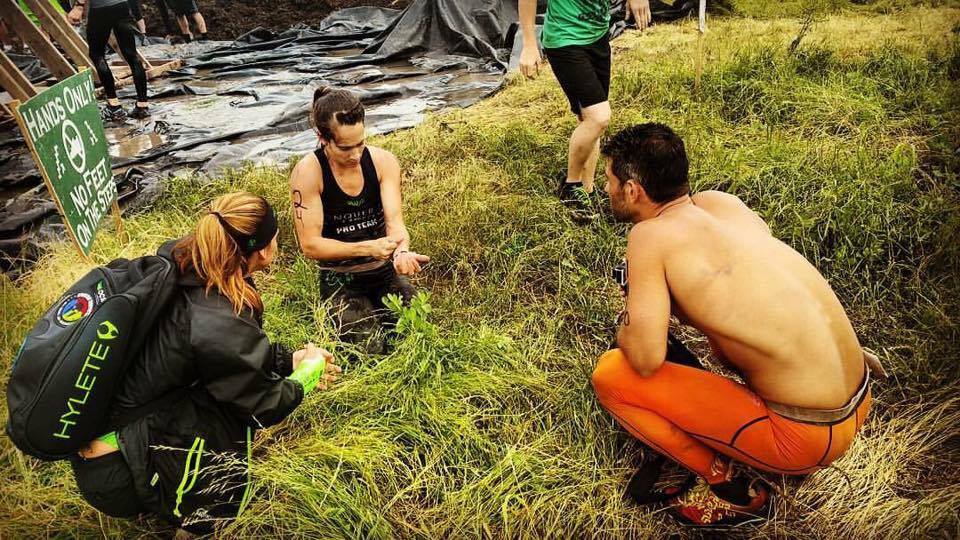Amelia Boone, Claude Godbout, Corinna Coffin, Sarah Watson, Brenna Calvert and Nikki Call. No, I did not just name the top six elite females from a recent race. Besides being members of Pro Teams representing race companies (Spartan Race, BattleFrog Series, and Conquer The Gauntlet), these athletes have something else in common, they have had serious injuries requiring medical appointments (surgery and/or casts in some cases) and weeks of recovery. With so many injuries from so many high-level athletes, the question of safety comes to mind and if we are asking too much of our top level athletes.
Over the next two articles, I will cover this topic from the perspective of elite/competitive athletes then in the next one open wave competitors. I separated them into two posts because training and overall goals are not the same for the two groups. Let’s start with the elites…
Unfortunately, injury is part of high-level competition so it will always be present on some level as people try to find that peak of performance. However, avoiding injury but still reaching your pinnacle of physical capability is part of the strategy involved in winning. If you train harder than everyone but never make it to the starting line, you already lost before the race started. Performing at your best involves pushing your body to harder and higher levels creating stress in training that causes a physiological improvement so you can perform on race day. It is natural for athletes to always push harder in an attempt to find their personal maximum potential. However, this must be balanced with your current levels of fitness.
If you want to be competitive at the highest levels you are going to push yourself to the razor’s edge of your physical limit. Occasionally during training or racing athletes take things too far. This includes things like stress fractures from overuse as in the case of Amelia Boone. Pushing yourself hard to the point of failure resulting in a bone-crushing fall as in Nikki Call…and then continuing to race for another couple of weeks. Furthermore, the hours spent on your feet moving, jumping, running, climbing and crawling increases your risk of injury solely from a probability standpoint. This was the case with
Claude Godbout, who jumped off an obstacle she had jumped off hundreds of times but landed with a debilitating injury and Brenna Calvert, who stepped in a hole on a downhill during BattleFrog Cincinnati twisting her knee resulting in fractured tibial plateau and minor meniscus damage.
In the end, injury is part of any sport and the answer to reducing the chances of it always lies in knowing your limits and building gradually but progressively. (I avoid using the term preventing because sometimes injury is just a result of a freak accident.) For overuse, we can do things like increase weekly mileage or training volume at a slow but consistent pace (10% is the typical max recommended amount) and take recovery (lower volume) weeks once a month. For example, if you ran 30 miles last week, you can run 33 this week and 36 next week before taking a lower volume week like 25 miles. This builds progressive, gradual stress but then allows for a period of recovery.
To prevent bone breaking falls we can continue to work on grip strength and practicing movements used in OCRs. Improving grip strength can fill up a good chunk of a book, so I will not go into the details here, but having a strong grip buys you time and confidence on obstacles. Adding in sport specific movements like climbing over walls, practicing on balance beams and rig practice all improve your ability to complete obstacles with less effort.
The tricky part of all of this is figuring out when to push ahead in order to redefine your limits and when to back off. You hear it all the time at event’s like World’s Toughest Mudder, “I decided to stop so I would not injure myself.” Are these athletes smart for calling it before their limit? Or are they weak for not pushing through the pain, which would have only resulted in physical discomfort and a higher placing in the overall standings? Unfortunately, it is a question that we usually do not find the answer to until it is too late.
Big thanks to Jim for suggesting the topic of this article
Picture of Corinna Coffin provided by Corinna Coffin
Picture of Sarah Watson provided by Sarah Watson, photo taken by Chosen Photography
Pictures of Nikki Call provided by Nikki Call
Picture of Brenna Calvert provided by Brenna Calvert
